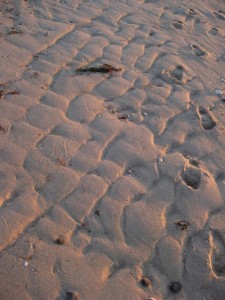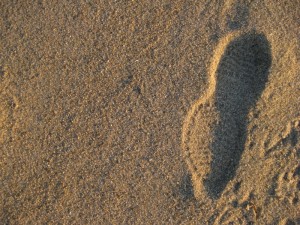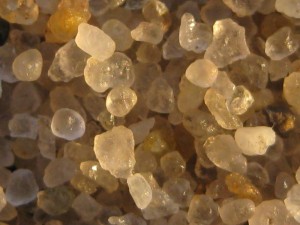Birth and death
I just appreciated nature a bit better after watching these animations regarding birth and death, compliments of Valdosta State University.
I just appreciated nature a bit better after watching these animations regarding birth and death, compliments of Valdosta State University.
Earlier, I posted on Powers of Ten. I've long been fascinated by the way numerous relatively similar things can aggregate into macro patterns such as the crisscross that you can see in the photo to the right.  Naturally occurring pattern like this abound on the beach.
Naturally occurring pattern like this abound on the beach.
How is it that sand dunes can naturally form out of random sand grains and random wind? Just because it's difficult to explain doesn't mean that it doesn't happen, of course.
The warm-up act of this post consists of three photos I recently took on a beach. First you see the "sand," then you focus in to see the individual grains of sand. Every one of those grains is different, even though they each look the same from a distance. They are a lot like people in that regard.
 The above photos are mere warm up act for this wonderful, mind-stretching display of smallness and largeness. I realize that I featured this display in an earlier post, but it is that well done.
The above photos are mere warm up act for this wonderful, mind-stretching display of smallness and largeness. I realize that I featured this display in an earlier post, but it is that well done.
What could you do if you drilled a tunnel all the way through the Earth and maintained a vacuum in the tunnel? You could jump in and reach the other side of the planet in only 42 minutes. These and other fun facts at How Stuff Work.
I think it's so utterly cool that this married couple discovered that the big rock decorating their garden was a meteorite that started its journey to Earth half a billion years ago. I write this post full well knowing that meteorites commonly strike our planet: there have been 1,086 meteorite "falls" (witnessed impacts) and 38,660 meteorite "finds" in the history of our planet. I once had the privilege to view the Barringer Crater in Arizona, a crater extending .73 miles in diameter caused by a meteorite impact only 40,000 years ago. I tend to think of the Earth as stable and the meteorites are striking us. The truth is that all of us are streaking through space on a huge rock we call Earth. It's equally amazing that the solar system once did not exist and that it will one day cease to exist. We are privileged to be cognizant of this amazing tour of space, passengers who are lucky to be alive and lucky to be conscious of this experience, all of us touring on the skin of our planet. All of this constitutes the most amazing and true story ever, but I've never yet read any of this in any newspaper headline.
This is a terrific journey. You get to travel from the Earth to the edge of the known universe and back, all in six minutes. It's a beautiful collection of graphics, along with a space-appropriate sound track. Bravo to the American Museum of Natural History.